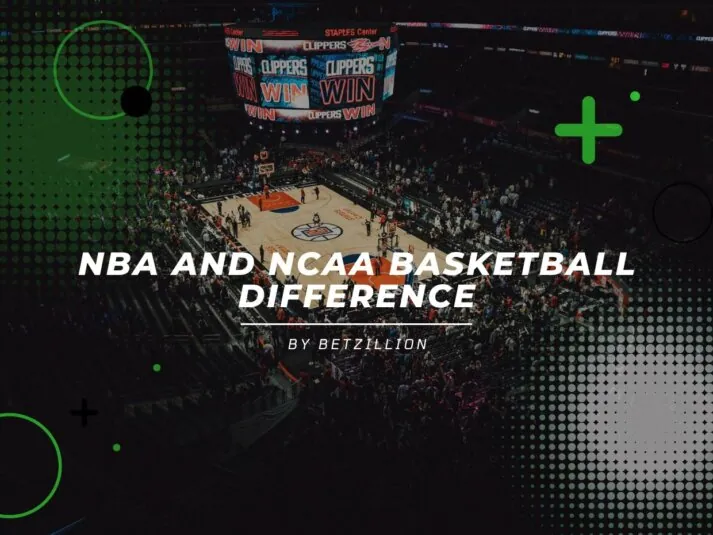Differences Between NBA and NCAA Basketball

NCAA basketball is college basketball governed by the National Collegiate Athletic Association. It features amateur athletes, typically students balancing academics and sports. On the other hand, the National Basketball Association (NBA) is a professional league that features the best basketball talent from around the world. Evidently, these two competitions operate on different levels, but there’s more that sets them apart.
In this article, I’ll walk you through the difference between NBA and NCAA basketball. I’ll cover how they differ regarding game time, rules, style of play, coaching, media coverage, and other core aspects. Let’s dive right in!
Game Time
Besides the level of competition, one key difference between NCAA basketball and the NBA is the game time.
| NCAA | NBA |
|---|---|
| NCAA basketball games are split into two 20-minute halves, adding up to 40 minutes of play. | NBA games are broken into four 12-minute quarters, making for a total of 48 minutes. |
It is essential to note that both formats allow for overtime periods, which typically last 5 minutes if the game is tied at the end of regular time.
Shot Clock
Another key difference between NCAA and NBA basketball is the shot clock, which is a time limit that determines how long a team can hold the ball before taking a shot.
| NCAA | NBA |
|---|---|
| Each team has 30 seconds to attempt a shot after gaining possession. If the shot hits the rim and they regain the ball, the shot clock resets to 20 seconds. They also have ten seconds to cross the half–court. | NBA teams have a shorter shot clock set at 24 seconds and 14 seconds after coming off the rim. Also, the teams only have 8 seconds to cross the half-court. |
3-Point Line
While the difference between the NBA vs NCAA 3-point line might seem minor, it has a big impact on the game. This Line determines the distance from which a successful shot earns three points instead of the usual two.
| NCAA | NBA |
|---|---|
| In the NCAA, the 3-point Line is set at 22 feet, 1¾ inches from the basket at its farthest point. And 21 feet, 7⅞ inches from the corners. | In the NBA, the 3-point Line is 23 feet and 9 inches from the basket at its farthest point and 22 feet from the corners. |
The slightly extended range in NBA basketball demands greater shooting accuracy, strength, and strategy.
Fouls
Another main difference when you compare NCAA basketball rules vs NBA lies in foul limits and penalties.
| NCAA | NBA |
|---|---|
| Players are allowed five personal fouls before they foul out. That is, they are substituted and sidelined for the rest of the game. | Players get a bit more leeway. Each player has six personal fouls before fouling out and being sent to the bench for the rest of the game. |
Personal Fouls
As I mentioned, each player has five personal fouls in the NCAA and six in the NBA. Also, the penalties are pretty much the same for fouling out. However, one difference between NBA and NCAA basketball is that in the NCAA, a player fouls out after accumulating five fouls. This can be a combination of personal and technical fouls. For instance, if a player racks up three personal fouls and two technical fouls, they would be disqualified from the game.
Conversely, an NBA player fouls out after reaching six fouls, which can also be a combination of personal and technical fouls. However, a player would also foul out after two technical fouls regardless of the number of personal fouls.
Interestingly, some of the best basketball bookmakers offer several prop betting markets centered around fouls. Bettors can bet on the total number of player or team fouls, the first player to foul out, total fouls in the game, etc.
Technical Fouls
Unlike personal fouls, technical fouls are violations of the game’s conduct rules and don’t always involve physical contact. They’re usually called for unsportsmanlike behavior, like arguing with referees, showing disrespect, or fighting.
A technical foul leads to the opposing team being granted free throws, but the number of free throws differs between the NCAA and NBA.
| NCAA | NBA |
|---|---|
| The opposing team is awarded two free throws and possession of the ball. | The opposing team gets one free throw, and the game continues from there. |
Team Fouls
Team fouls refer to the total number of personal and technical fouls committed by all players on a team during a specific part of the game. When a team hits a certain foul limit, the opposing team enters the bonus, which grants them free throws after every additional foul.
| NCAA | NBA |
|---|---|
| The bonus kicks in after the seventh team fouls in a half. The opposing team is given a one-and-one free throw opportunity. This means they need to make the first shot to get a second attempt. After the tenth team foul, the penalty increases to two free throws for every foul. | The bonus is awarded after a team commits four team fouls in a quarter. After the four fouls, the opposing team is automatically given two free throws for each subsequent foul. |
Time-outs
Another significant aspect of NCAA and NBA differences is the number of time-outs (breaks).
| NCAA | NBA |
|---|---|
| Each team has a maximum of four 30-second time-outs per game. | Each team is allowed a maximum of six time-outs per game. |
There are also other time-outs, like the full game time-outs and time-outs for commercial breaks. These time-outs are not called by the team coaches. Also, coaches cannot call time-outs during live ball situations.
Uniform
Basketball jerseys in the NCAA and NBA are quite similar. The only difference is in the penalties for breaching the uniform or jersey codes.
| NCAA | NBA |
|---|---|
| If a player violates the uniform code, the referee will blow the whistle, and the player must correct the issue before continuing. | Breaking the uniform code results in a fine for the player rather than a stoppage in play. |
Player Age and Experience
As you probably already know, the NCAA features sound student-athletes who are looking to pursue a career in the NBA. On the other hand, the NBA consists of seasoned professional basketball players from different parts of the world.
Style of Play and Coaching
When it comes down to basic basketball, the NBA and NCAA are pretty much similar. However, all the slight differences, such as the NBA court size vs NCAA, the rules of the game, experience, and talent of the players, cause a few differences in the style of play and coaching.
Basically, the NBA is faster-paced and highlights individual talent more. On the other hand, the NCAA often focuses on team play, strategy, and coaching adjustments due to the younger, less-experienced players.
Financial Aspects
Financially, the NBA and NCAA are wide apart. Financial negotiations play a huge role in the NBA. Players sign multimillion-dollar contracts and also earn from endorsements, sponsorship deals, and media rights agreements.
On the other hand, NCAA players have long been regarded as amateurs. Until recently, they were only allowed to receive scholarships and stipends. However, recent rule changes now allow college athletes to profit from their name, image, and likeness, though their earnings still don’t come close to that of the NBA.
Media Coverage and Publicity
Evidently, NBA basketball also significantly eclipses the NCAA in terms of media coverage and publicity. However, the NCAA also gets a reasonable degree of attention, especially during March Madness, when even non-basketball fans watch and punters massively bet on college basketball.
Another slight difference is the way the media tends to portray matches and teams in the NCAA and NBA. In the NBA, the focus is usually directed toward star players, big teams, etc. However, the NCAA tends to highlight team stories and upsets more.
Final Words
NBA and NCAA basketball share many similarities in terms of the basic rules, such as scoring, fouls, and gameplay structure. Both leagues follow the same core principles of basketball with reasonable fanbase and followership. Also, both have almost the same betting markets with a zillion ways to bet on their games.
However, key differences like player age and experience, finances, and media coverage set them apart. Other slight contrasts include areas like court size, shot clock duration, and game length. Despite these differences, both the NBA and NCAA uniquely portray the essence of basketball as an exciting and diverse sport.
Related articles
Biggest Preseason Betting Underdogs to Ever Win an NBA Championship
Who Is Better: Michael Jordan or LeBron James?






